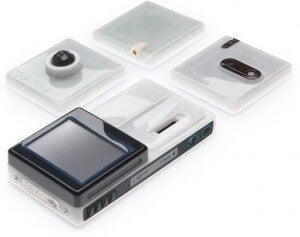Assemble Your Own Gadgets at Bug Labs

Share
If you ever tried to make a camera phone by taping a camera to a phone then I've found your soulmate. Bug Labs is an innovative New York based company that sells modular hardware. They are the Lego of gadgets. Using a base and specialized modules, customers can build almost any high tech device they desire. Want a camera triggered off a motion sensor? Easily done. Want that same camera to sound an alarm and project a warning video on a wall? Just add some more modules. It's all open source and it's set to transform users into innovators. Skip ahead to watch a video of Bug Labs at CES 2009 from Computer TV.

Modular hardware lets you prototype almost anything. Bug Labs sells a basic bundle that can get you going today.
When Bug Labs says open sourced, they mean open sourced. The base is a Linux computer, every hardware module can be easily pried open and messed with, and all the software is available online for your tinkering. It's all part of founder Peter Semmelhack's vision of a rapid prototyping system that allows anyone with the inclination to build whatever they want. Businesses can get a jump start on designing the next top selling gadget. Schools (who get a 15% discount) have a powerful new educational tool. Reclusive super villains can fully customize their electronics to fit their diabolical needs. It's a win-win-win situation.
The number of available modules is growing. According to their marketing department, 81 are planned in total. Right now you can buy: the base (power, computer, simple button controls), gps, motion detector (with accelerometers), digital camera, LCD touchscreen, audio (speaker and mic), short range wifi (for PAN and M2M), and a break out board with USB port. You can buy the most basic of these in a bundle at the Bug store. While not on the store website, there is a projector module (using the TI DLP chip), 3G module, keyboard, and sensor pack that are supposed to be available now or soon.
Just a quick note about that breakout board. It's called the Von Hippel, named after the MIT Professor and author of Democratizing Innovation. Not only does the board really fit with Von Hippel's philosophy, it also provides the widest possibilities of prototyping with a Bug device. I'll let Alicia the Bug wrangler explain in this short video:
Be Part of the Future
Sign up to receive top stories about groundbreaking technologies and visionary thinkers from SingularityHub.


I have to admire Bug Labs and what they are trying to do. Modular hardware and software, with a true open source commitment, is amazing. Not that there isn't some sort of licensing. Specifically, Bug Labs authored code is covered under GPL v2, GPL v3, EPL, and BSD. The community they are building has the potential to ramp up the collaboration of users and allow them to become a dominant source of innovation. As we've seen with MIT's Registry of Standard Biological Parts, or with Willow Garage's approach to robotics, expanding the base of people with access to technology is a compelling way to grow an industry.
Of course, the fact remains that Bug Labs really isn't for everyone. While costs are cheap for the prototyping market (base is around $250, modules $40-$100+), this is not something I would invest in lightly. On a tech side, they've had problems with including wifi in their base. Also, Bug Labs relies on its community for a lot of support and direction. That's wonderfully democratic, but not the quickest way to get things done. Of the "81" modules proposed, only 8 are available this second at the store, and many proposed modules will have to be developed/designed by users rather than Bug Labs themselves. Again, that's a cool idea, but it may slow things down.
Yet if there's one thing that really endears Bug Labs to me, it's their sense of humor. Their blog, community pages, and even job titles all sparkle with dead pan and "screw the man" jokes. Heck, their debut video on YouTube showed them making things out of wood. A prank they apologized for and then topped in their next video. They're fun guys with a fun product and a great slogan: "Think what you want, then make it."
You had me at 'hello', Bug Labs, you had me at 'hello'.
Related Articles

This Portable Wind Turbine Is the Size of a Water Bottle and Charges Devices in Under an Hour

Mojo Vision’s New Contact Lens Brings Seamless Augmented Reality a Step Closer
The Weird, the Wacky, the Just Plain Cool: Best of CES 2020
What we’re reading